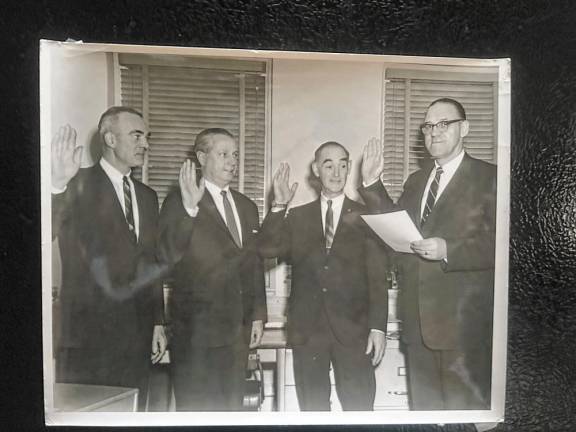
There were just 2,501 people living in year-round homes in West Milford when the United States became part of an ongoing worldwide bloody war Dec. 7, 1941.
Life in the township changed greatly after World War II officially ended Sept. 2, 1945.
Township residents lived in about 12 or so self-sufficient communities, each usually with a general store that sometimes included a post office, rural one- or two-room schoolhouses (three rooms in Newfoundland), and a church.
Police Chief John Moeller was the one-man full-time police department. If he needed reinforcements for an emergency, there was a roster of about 40 “special police” officers living in the various communities. Although they had no formal training, they had handguns and knew how to use them and instinctively were aware of how to respond if Moeller called for help. They were paid by the township for the hours they worked.
West Milford’s population increased greatly after World War II, when large numbers of people from New York City and New Jersey cities, wanting to experience country living, moved to the 80-square-mile township.
Before then, there were few rules to live by. People were free to do what they wanted with their property without seeking approvals as there were no existing laws, boards or inspectors.
In 1960, the year-round population increased to 8,157. By 2020, there were 24,862 permanent residents.
Surprisingly, the township population seems to be decreasing since then. Between 2000 and 2023, there were 1,961 fewer people living in West Milford. The peak population was 27,628 in 2009.
Time out for study
By the time Wilbur Fredericks was mayor in 1996, there were so many builders submitting subdivision proposals to construct homes that the Township Committee, the title for the local governing board, voted to put a 90-day moratorium on applications for major subdivisions to give officials time to study growth patterns and related subjects.
It took awhile for the committee to agree on that amount of time for the action. The original proposal was for a 180-day moratorium.
Initially, Fredericks called for “an infantry of dedicated citizens to come forth and form a new battleline against the invasion of West Milford by the builders’ eloquent attorneys.”
He complained that a week earlier at a public hearing on an ordinance to upgrade lot-size requirements, out-of-town builders and their attorneys arrived at West Milford Town Hall very early and occupied the front seats of the meeting room, “forcing many citizens who were there to oppose the ordinance to stand up or take a back seat.”
“The builders and their attorney leveled their heavy guns at the ordinance and forced three committee members to retreat,” Fredericks said. “Only Committeeman Gilbert Terhune and I stood our ground. We were left to defend poor little West Milford, its citizens and taxpayers.
“This ordinance was recommended for adoption by the Industrial Commission, our newly hired planner and the Planning Board. Even Committeeman William Dunnigan, who twice declared at a Planning Board meeting that he would support the ordinance and voted for its introduction, then gave in to the builder’s blitz.”
Fredericks feared that many of the committeemen were “taking the short-range view, only seeing what may happen today, tomorrow or the next week, rather than three, five or 10 years hence.”
He warned that the plans of special-interest groups would lead the township down the road to uncontrolled growth, congestion, high taxes and double sessions in the schools.
The mayor believed that builders wanted to build on large tracts of land zoned for small lots. If they were really interested in our town, they would cut out the double talk and accept the proposed upgrading in lot sizes, he said.
Dunnigan would have liked to kill the proposed moratorium but finally he went along with it in hopes of establishing a controlled growth pattern.
Terhune suggested that township growth should be regulated according to a master plan. He saw the need for proper planning “before land is used up.”
Forced to sell land
Frederick Irving Vreeland was one of the residents who was concerned about the expected rapid growth. At a council meeting, he said he was being forced to sell Macopin land that was in his family for generations to pay his property tax increases.
He tried to sell the land several times unsuccessfully before a developer bought it with plans to build 170 homes on half-acre lots.
Other large landowners had the same complaint.
Before many more years passed, West Milford residents and their elected officials survived the initial population growth challenges.
Those in office now are still learning that there will always be changing times with new problems to solve.
As the late John Fredericks, son of the deceased mayor, often remarked, “Nothing remains the same.”